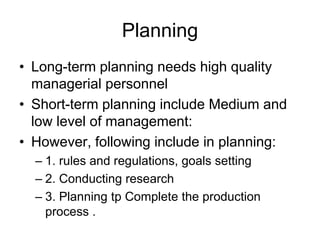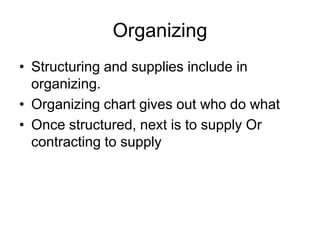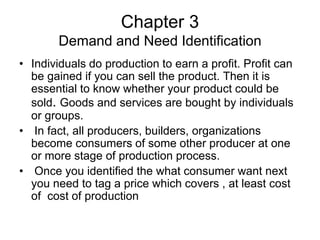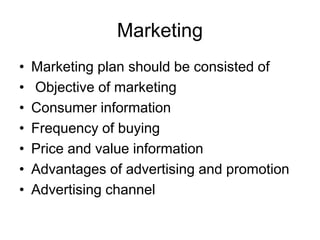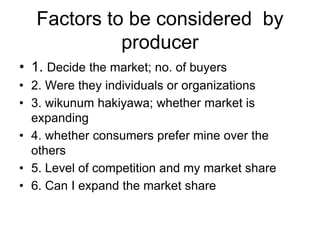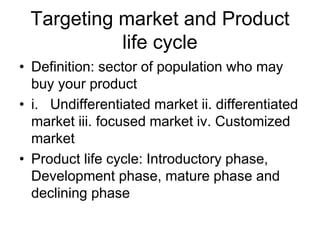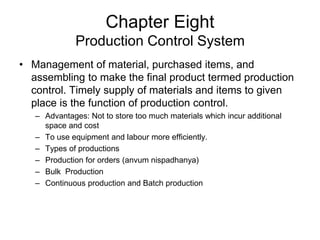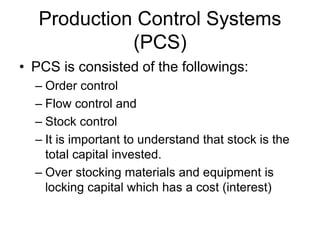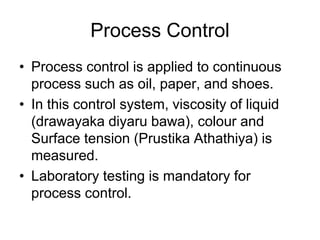Operation Management KG Ousl
- 1. Introduction to Operations Management W. A. Upananda Former Asst. Professor/ Senior Lecturer July 14 2019
- 2. Chapter One Evolution of Production Operations • At the early stage of mankind, operations are confining to produce food, clothing, and shelter. • The development stages divided into three stages: Adhi Kalina, Madyakalina, industry revolution and modern eras. • From 500 AD to 1400 Ad is Madyakalina • 1400 to 1700 to emergence of Science • 1700 to Industrial revolution
- 3. Changes taken place as a result of Industrial revolution • 1. Usage of machines • 2. Using engine to operate machines • 3. Production had taking place in factories. • Noteworthy innovation – 1400 Printing machine Gutanberg – 1769 James Watt
- 4. 4 Chapter Two Operations Management is: The business function responsible for planning, Organizing/coordinating, and controlling the resources needed to produce products and services for a company. Then production management is the science of planning, organizing, and control of production process.
- 5. Production process • Once determined to start a production following steps needed to complete operations: • 1. Identify the consumer demand • 2. Design and engineering the product • 3. Planning for production • 4. Production of implements, and Factory designs (including finding location for machinery) • 5. Measurement of works and estimating • 6. Production control systems • 7. quality control.
- 6. Matching OM with Management Principles Basic Functions of Management Basic Function of OM Specific Functions of OM Planning Planning Short-and long-term (need identification, Input identification ) Planning include :Decision making Researching, cost estimating, product design Organizing/ coordination Process (Management of factory, production and Human resources Organizing: Piriyatha organizing structuring and supply Management : Directing, supervising, reporting and correction Control Products, quality of durable and non-durable
- 7. 7 Operations Management is: • A management function • An organization’s core function • In every organization whether Service or Manufacturing, profit or Not for profit • Operation management is science of product/service planning, organizing and control.
- 8. Production system (Paddathi) • Three things are involved: – Inputs : natural resources, Human resources and physical resources – Process: Management sphere, production sphere, and employee sphere – Output : Durable and non-durable products
- 9. Types of Processes • Management process (decision making according to plans) • Production processes (conversion of inputs into outputs with maximum efficiency) • Employee process (Utilization of human resources to the maximum)
- 10. Types of inputs • Need of inputs vary with the types of good that intended to produce. • Two types of goods Durables (at least for three years) • Non-durables (< three years) • Accordingly following inputs also vary: • Natural resources, Finance, Capital, Energy, Human capital (Knowledge)
- 11. 11 OM’s Transformation Role • Operations are done to add value – Increase product value at each stage – Value added is the net increase between output product value and input material value [Value of output - (Value of Input + cost of operations) = Added value • An efficient transformation may reduce cost of production – Efficiency – means performing activities well for least possible cost
- 12. Production Management at Home • Production management can be defined as the science of planning, organizing, and controlling of a production. • Example, kitchen, family • Kitchen is the factory which has layout to reach each machines (grinding, scraping, preparation of curries, rice cooker) with minimum of time and with ease (Work measurement)
- 13. Stages of production Management • 1. Identification of consumer needs • 2. Selecting the Nature and quality of product/service • 3. Determine production planning • 4. Preparation of implements and machinery for production • 5. Inputs for production system • 6. Controlling production and quality
- 14. Important • Planning include planning for others (subordinators) • Organizing include organizing for maximum efficiency (input/output) • Control include process, Quality and cost to satisfy customers.
- 15. Planning • Long-term planning needs high quality managerial personnel • Short-term planning include Medium and low level of management: • However, following include in planning: – 1. rules and regulations, goals setting – 2. Conducting research – 3. Planning tp Complete the production process .
- 16. Planning • Functions of Planning – Long-term (> 5 years) and Short term (<5 years) – Planning includes: – 1.Setting Goals and objectives, and procedures – 2. conducting research – 3. production design and cost
- 17. Planning include • 1. Decision making • 2. researching • 3. Designing • 4. Engineering • 5. Activity planning
- 18. Organizing • Structuring and supplies include in organizing. • Organizing chart gives out who do what • Once structured, next is to supply Or contracting to supply
- 19. Controlling • Controlling consisted of – Direction – Inspection or supervissing (mehayaweema) – Reporting and – Correction
- 20. Chapter 3 Demand and Need Identification • Individuals do production to earn a profit. Profit can be gained if you can sell the product. Then it is essential to know whether your product could be sold. Goods and services are bought by individuals or groups. • In fact, all producers, builders, organizations become consumers of some other producer at one or more stage of production process. • Once you identified the what consumer want next you need to tag a price which covers , at least cost of cost of production
- 21. Marketing • Marketing plan should be consisted of • Objective of marketing • Consumer information • Frequency of buying • Price and value information • Advantages of advertising and promotion • Advertising channel
- 22. Factors to be considered by producer • 1. Decide the market; no. of buyers • 2. Were they individuals or organizations • 3. wikunum hakiyawa; whether market is expanding • 4. whether consumers prefer mine over the others • 5. Level of competition and my market share • 6. Can I expand the market share
- 23. Identification of market • Conditions to termed market: i. There should be a need for individuals ii. they must capability to buy goods iii. Willingness to exchange goods with money iv. They must have authority to buy goods. • Types of market: industrial markets (buys for production) and consumer market (buy for consumption) • Market Segmentation: population, geography, rural/urban, age, gender, income level, spending pattern.
- 24. Targeting market and Product life cycle • Definition: sector of population who may buy your product • i. Undifferentiated market ii. differentiated market iii. focused market iv. Customized market • Product life cycle: Introductory phase, Development phase, mature phase and declining phase
- 25. Marketing Mix and Pricing • 4Ps: Product, price, promotion and place • 7Ps: Product, price, promotion, place, people, process, physical environment. • Pricing strategies: premium pricing/cost pricing, penetration pricing (lowest), economy pricing (pricing with decreased cost of production) , competitive pricing and skimming pricing (vary with the market).
- 26. Chapter 4 Engineering • For any product there are two things Design and Engineering • Product design (Appearance and activities involved. • Start with a new idea and he has to make a rough sketch and then a prototype. • Next add solutions to problem such as Safety, usage friendliness, cost , production posibility
- 27. Production engineering process • This process include feasibility of production and presentation of the product Engineering process is consisted of 4 activities Power, assembling, interior design • process and flow charting Developing prototypes Technical details and presentation
- 28. Chapter 5 Production Planning • After designing and engineering, next step is to planning for production: • This is the operationalization of production which consisted of : • 1. Ability to supply, Capacity, quality, no. of employees, material and machine requesting time, operation methods, Transporting, selection of best production process with maximum savings (arapirimasma ).
- 29. Selection of operation methods • Factors to be considered for selection of operation methods: • 1. Ability to supply (existing machinery) • 2. Capacity to meet the demand • 3. Quality (can we maintain the quality) • 4. Number of employees • 5. Material storage • 6. To supply goods at minimum cost while maintaining quality.
- 30. Process of activity planning • A array of activities consisted of several operations. • Steps of planning process: – Write down the processes sequentially – Selection of sites/places – Analysis of flow of works – Analysis of operation methods
- 31. Symbols used to describe activities • . • Operation Motion Inspection Expectation • Time and distance have to be indicated • Advantages of flow charts: • 1. Identify the expensive activities • 2. Ensure things are at proper places • 3. places where inspection should be made • 4. Placement of machine for maximum efficiency
- 32. Analysis of operations • Purpose: To reduce the cost of production. There is a cost for every motion and need to study to select the least cost motion but does the needful. • Before any operation, one must prepare for the task. This takes time which incur cost. • Next, there are several types of machines; • For example, if there are three drilling machines which make holes vertically, controlled holes, and multiple holes.
- 33. Example: Selection of machine for minimum cost of production Method Prepar ation cost Rs. Cost per unit 1 Cost 10 Per 100 Unit 1, 000 10, 000 Vertical Drilling 120 100 220 112 101 100 100 Controll ed drilling 200 40 240 60 42 40 40 Multiple drilling 200,00 10 20010 2010 210 30 12
- 34. Chapter 6 Supply of implements, design and engineering • Preparation of implements for production:1. designing machines and equipment 2. Ordering approved machines 3, Designing specific equipment 4. Installing supervision and test runs. • Equipment may need when: Starting a factory, starting a new production, modernization, changing dimensions, introducing new pn. method
- 35. Selection of a Site for Factory • Factored to be considered: Access to market, raw material 2. labour supply • 3. Supply of energy/power and water • 4. Availability of production incentives provided by the state
- 36. Machine room (Yantragara) Planning • This is part of factory design; product based and process based machine rooms are different. • Once product based or process based machine room is decided, Machine room is designed. • Advantages of Good machine room design: i. parsimony in using land ii. cost of equipment could be reduced iii. Frequency of movements can reduced iv. Maximum usage of men and machines v. protection and comfort.
- 37. Chapter 7 Measuring and Cost estimates • This is important for : • Estimating time for a task both human and machine. From that estimated time we can determine the no. of items to be produced by a worker from a given machine. • Methods: • Using stopwatches and measure time for each components of the task. And finally adding up to determine the total time for the task.
- 38. Cost estimates • This is forecasting of estimates before starting a work/task. • Cost estimating is made using units. For example, in house construction estimates are given for linear feet of wall, cubic feet of concrete, square feet of meters of a roof etc.. • In estimating material units are Kgs or Pounds. • For a book, the unit of estimate is page,
- 39. Chapter Eight Production Control System • Management of material, purchased items, and assembling to make the final product termed production control. Timely supply of materials and items to given place is the function of production control. – Advantages: Not to store too much materials which incur additional space and cost – To use equipment and labour more efficiently. – Types of productions – Production for orders (anvum nispadhanya) – Bulk Production – Continuous production and Batch production
- 40. Order production and Bulk production • Order production are made on orders while bulk productions are made to stock. • Tvs, Shoes, canned food are made in bulk without specific orders. • Ships, planes, High valued Motor cars are examples for order productions.
- 41. Continuous and Non-continuous Production (Akanda and Savirama Production) • Continuous production is to produce similar products which are used by majority of population. • Non-continuous productions (Savirama) made from time to time to full fill an order. • Order control: Consisted of Six steps • Billing, making flow charts, work order charts, inspections, reporting and correction.
- 42. Production Control Systems (PCS) • PCS is consisted of the followings: – Order control – Flow control and – Stock control – It is important to understand that stock is the total capital invested. – Over stocking materials and equipment is locking capital which has a cost (interest)
- 43. Order Control Process Preparn. of bills: Product name Product Num. Quantity Date Rout chart This display the steps required Work order chart Mat. Supply From the stores Supervision/ Inspection Reporting Part No. Nos. of parts Required Nos. Of parts Units Stock No. Date Name of the item Item No. Serial No. Material Date This is done in order to determine the time required to produce one unit/item Product. Control differ from product planning work order. From time to time inspections are made. Matching planned product and actual product This is to inform authorities which have powers to change the production flow.
- 44. Flow control and Stock Control • Flow control: is used in continuous production and flow charts are not necessary since it is already planned. • It is required for non-continuous (Savirama/kadin kada) production. It contains: i. deciding quality and quantity of products ii. Purchase material required • iii. issuing materials • Stock control: Stock is the total value of the business. Stock is invested capital. • It include, factory, machinery, buildings, equipment and materials. • Stock control means to get material and equipment in enough quantities.
- 45. Chapter Nine Production Quality control systems • Quality control can be defined as,’ a process which attempt to bring the product sellable and attractive to the customers’. • It is consisted of : Supervising, reporting and correction. • Inspection (supectionaya) is a method of supervising(Adickshanaya). Inspection include laboratory testing, and analizing.
- 46. Types of control • There are two types of controls: – Quality control of products – Quality control of processes • Product quality control is done at international level. For example, ISO 9000 is quality management standard. • ISQC is international Standard on quality control.
- 47. Process Control • Process control is applied to continuous process such as oil, paper, and shoes. • In this control system, viscosity of liquid (drawayaka diyaru bawa), colour and Surface tension (Prustika Athathiya) is measured. • Laboratory testing is mandatory for process control.















